[English] 日本語
 Yorodumi
Yorodumi- PDB-6ehm: Model of the Ebola virus nucleocapsid subunit from recombinant vi... -
+ Open data
Open data
- Basic information
Basic information
| Entry | Database: PDB / ID: 6ehm | ||||||||||||
|---|---|---|---|---|---|---|---|---|---|---|---|---|---|
| Title | Model of the Ebola virus nucleocapsid subunit from recombinant virus-like particles | ||||||||||||
 Components Components |
| ||||||||||||
 Keywords Keywords | VIRUS LIKE PARTICLE / nucleocapsid / virus-like particle | ||||||||||||
| Function / homology |  Function and homology information Function and homology informationhost cell endomembrane system / viral RNA genome packaging / helical viral capsid / symbiont-mediated suppression of host JAK-STAT cascade via inhibition of STAT1 activity / viral budding from plasma membrane / viral nucleocapsid / host cell cytoplasm / symbiont-mediated suppression of host innate immune response / symbiont-mediated suppression of host type I interferon-mediated signaling pathway / ribonucleoprotein complex ...host cell endomembrane system / viral RNA genome packaging / helical viral capsid / symbiont-mediated suppression of host JAK-STAT cascade via inhibition of STAT1 activity / viral budding from plasma membrane / viral nucleocapsid / host cell cytoplasm / symbiont-mediated suppression of host innate immune response / symbiont-mediated suppression of host type I interferon-mediated signaling pathway / ribonucleoprotein complex / host cell plasma membrane / virion membrane / structural molecule activity / RNA binding / membrane Similarity search - Function | ||||||||||||
| Biological species |  | ||||||||||||
| Method | ELECTRON MICROSCOPY / subtomogram averaging / cryo EM / Resolution: 7.3 Å | ||||||||||||
 Authors Authors | Wan, W. / Kolesnikova, L. / Clarke, M. / Koehler, A. / Noda, T. / Becker, S. / Briggs, J.A.G. | ||||||||||||
| Funding support |  Germany, 3items Germany, 3items
| ||||||||||||
 Citation Citation |  Journal: Nature / Year: 2017 Journal: Nature / Year: 2017Title: Structure and assembly of the Ebola virus nucleocapsid. Authors: William Wan / Larissa Kolesnikova / Mairi Clarke / Alexander Koehler / Takeshi Noda / Stephan Becker / John A G Briggs /    Abstract: Ebola and Marburg viruses are filoviruses: filamentous, enveloped viruses that cause haemorrhagic fever. Filoviruses are within the order Mononegavirales, which also includes rabies virus, measles ...Ebola and Marburg viruses are filoviruses: filamentous, enveloped viruses that cause haemorrhagic fever. Filoviruses are within the order Mononegavirales, which also includes rabies virus, measles virus, and respiratory syncytial virus. Mononegaviruses have non-segmented, single-stranded negative-sense RNA genomes that are encapsidated by nucleoprotein and other viral proteins to form a helical nucleocapsid. The nucleocapsid acts as a scaffold for virus assembly and as a template for genome transcription and replication. Insights into nucleoprotein-nucleoprotein interactions have been derived from structural studies of oligomerized, RNA-encapsidating nucleoprotein, and cryo-electron microscopy of nucleocapsid or nucleocapsid-like structures. There have been no high-resolution reconstructions of complete mononegavirus nucleocapsids. Here we apply cryo-electron tomography and subtomogram averaging to determine the structure of Ebola virus nucleocapsid within intact viruses and recombinant nucleocapsid-like assemblies. These structures reveal the identity and arrangement of the nucleocapsid components, and suggest that the formation of an extended α-helix from the disordered carboxy-terminal region of nucleoprotein-core links nucleoprotein oligomerization, nucleocapsid condensation, RNA encapsidation, and accessory protein recruitment. | ||||||||||||
| History |
|
- Structure visualization
Structure visualization
| Movie |
 Movie viewer Movie viewer |
|---|---|
| Structure viewer | Molecule:  Molmil Molmil Jmol/JSmol Jmol/JSmol |
- Downloads & links
Downloads & links
- Download
Download
| PDBx/mmCIF format |  6ehm.cif.gz 6ehm.cif.gz | 63.2 KB | Display |  PDBx/mmCIF format PDBx/mmCIF format |
|---|---|---|---|---|
| PDB format |  pdb6ehm.ent.gz pdb6ehm.ent.gz | 31.3 KB | Display |  PDB format PDB format |
| PDBx/mmJSON format |  6ehm.json.gz 6ehm.json.gz | Tree view |  PDBx/mmJSON format PDBx/mmJSON format | |
| Others |  Other downloads Other downloads |
-Validation report
| Arichive directory |  https://data.pdbj.org/pub/pdb/validation_reports/eh/6ehm https://data.pdbj.org/pub/pdb/validation_reports/eh/6ehm ftp://data.pdbj.org/pub/pdb/validation_reports/eh/6ehm ftp://data.pdbj.org/pub/pdb/validation_reports/eh/6ehm | HTTPS FTP |
|---|
-Related structure data
| Related structure data |  3871MC  3869C  3870C  3872C  3873C  3874C  3875C  3876C  6ehlC M: map data used to model this data C: citing same article ( |
|---|---|
| Similar structure data |
- Links
Links
- Assembly
Assembly
| Deposited unit | 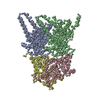
|
|---|---|
| 1 |
|
- Components
Components
| #1: Protein | Mass: 83387.500 Da / Num. of mol.: 2 Source method: isolated from a genetically manipulated source Source: (gene. exp.)   Homo sapiens (human) / References: UniProt: P18272 Homo sapiens (human) / References: UniProt: P18272#2: Protein | Mass: 28250.811 Da / Num. of mol.: 2 Source method: isolated from a genetically manipulated source Source: (gene. exp.)   Homo sapiens (human) / References: UniProt: Q05322 Homo sapiens (human) / References: UniProt: Q05322 |
|---|
-Experimental details
-Experiment
| Experiment | Method: ELECTRON MICROSCOPY |
|---|---|
| EM experiment | Aggregation state: HELICAL ARRAY / 3D reconstruction method: subtomogram averaging |
- Sample preparation
Sample preparation
| Component | Name: Ebola virus - Mayinga, Zaire, 1976 / Type: VIRUS Details: Recombinantly expressed virus-like particles produced by expression of nucleoprotein, VP24, VP35, VP40. Entity ID: all / Source: RECOMBINANT | ||||||||||||||||||||
|---|---|---|---|---|---|---|---|---|---|---|---|---|---|---|---|---|---|---|---|---|---|
| Source (natural) | Organism:  | ||||||||||||||||||||
| Source (recombinant) | Organism:  Homo sapiens (human) / Cell: HEK 293T Homo sapiens (human) / Cell: HEK 293T | ||||||||||||||||||||
| Details of virus | Empty: NO / Enveloped: YES / Isolate: STRAIN / Type: VIRUS-LIKE PARTICLE | ||||||||||||||||||||
| Virus shell | Name: Nucleocapsid / Diameter: 280 nm | ||||||||||||||||||||
| Buffer solution | pH: 7.4 | ||||||||||||||||||||
| Buffer component |
| ||||||||||||||||||||
| Specimen | Embedding applied: NO / Shadowing applied: NO / Staining applied: NO / Vitrification applied: YES | ||||||||||||||||||||
| Specimen support | Grid material: COPPER / Grid mesh size: 300 divisions/in. / Grid type: C-flat 2/1 3C | ||||||||||||||||||||
| Vitrification | Instrument: FEI VITROBOT MARK II / Cryogen name: ETHANE / Humidity: 95 % |
- Electron microscopy imaging
Electron microscopy imaging
| Experimental equipment |  Model: Titan Krios / Image courtesy: FEI Company |
|---|---|
| Microscopy | Model: FEI TITAN KRIOS |
| Electron gun | Electron source:  FIELD EMISSION GUN / Accelerating voltage: 300 kV / Illumination mode: FLOOD BEAM FIELD EMISSION GUN / Accelerating voltage: 300 kV / Illumination mode: FLOOD BEAM |
| Electron lens | Mode: BRIGHT FIELD / Nominal magnification: 81000 X / Nominal defocus max: 4500 nm / Nominal defocus min: 2000 nm / Cs: 2.7 mm / C2 aperture diameter: 50 µm / Alignment procedure: ZEMLIN TABLEAU |
| Specimen holder | Cryogen: NITROGEN / Specimen holder model: FEI TITAN KRIOS AUTOGRID HOLDER |
| Image recording | Average exposure time: 2.3 sec. / Electron dose: 3.4 e/Å2 / Detector mode: SUPER-RESOLUTION / Film or detector model: GATAN K2 QUANTUM (4k x 4k) |
| EM imaging optics | Energyfilter name: GIF Quantum LS / Energyfilter upper: 10 eV / Energyfilter lower: -10 eV |
| Image scans | Width: 3708 / Height: 3708 / Movie frames/image: 5 / Used frames/image: 1-5 |
- Processing
Processing
| EM software |
| |||||||||||||||||||||||||||||||||||||||||||||
|---|---|---|---|---|---|---|---|---|---|---|---|---|---|---|---|---|---|---|---|---|---|---|---|---|---|---|---|---|---|---|---|---|---|---|---|---|---|---|---|---|---|---|---|---|---|---|
| Image processing | Details: Frames were aligned using K2Align software, based off the MotionCorr algorithm. Tomograms were reconstructed with IMOD, using stripwise CTF-correction and weighted back projection. ...Details: Frames were aligned using K2Align software, based off the MotionCorr algorithm. Tomograms were reconstructed with IMOD, using stripwise CTF-correction and weighted back projection. Subtomogram averaging was performed using scripts derived from TOM, AV3, and DYNAMO. | |||||||||||||||||||||||||||||||||||||||||||||
| CTF correction | Details: CTF amplitude correction was performed during the wedge-weighted subtomogram averaging step. Type: PHASE FLIPPING ONLY | |||||||||||||||||||||||||||||||||||||||||||||
| Symmetry | Point symmetry: C1 (asymmetric) | |||||||||||||||||||||||||||||||||||||||||||||
| 3D reconstruction | Resolution: 7.3 Å / Resolution method: FSC 0.143 CUT-OFF / Num. of particles: 1 / Algorithm: BACK PROJECTION Details: Local resolution was estimated using moving window FSC calculations. Resolution varies from 7.3 to 15.2 Angstroms. Num. of class averages: 1 / Symmetry type: POINT | |||||||||||||||||||||||||||||||||||||||||||||
| EM volume selection | Details: Points along the helical axis were manually placed to define a spline. A cylindrical grid as defined at a given radius from the spline; grid spacing was chosen to provide ~4x oversampling. Num. of tomograms: 63 / Num. of volumes extracted: 379428 / Reference model: None | |||||||||||||||||||||||||||||||||||||||||||||
| Atomic model building | Protocol: RIGID BODY FIT Details: Nucleoprotein model from Ebola virus nucleoprotein 1-450 was first rigid body fitted into the inner nucleoprotein densities. Densities were then subtracted, and VP24 pdb was then fit into ...Details: Nucleoprotein model from Ebola virus nucleoprotein 1-450 was first rigid body fitted into the inner nucleoprotein densities. Densities were then subtracted, and VP24 pdb was then fit into remaining densities. All models were rigid-body fitted using UCSF Chimera. |
 Movie
Movie Controller
Controller



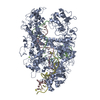

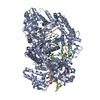
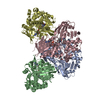
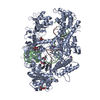

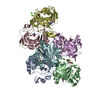
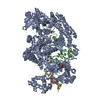
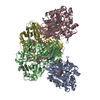
 PDBj
PDBj
